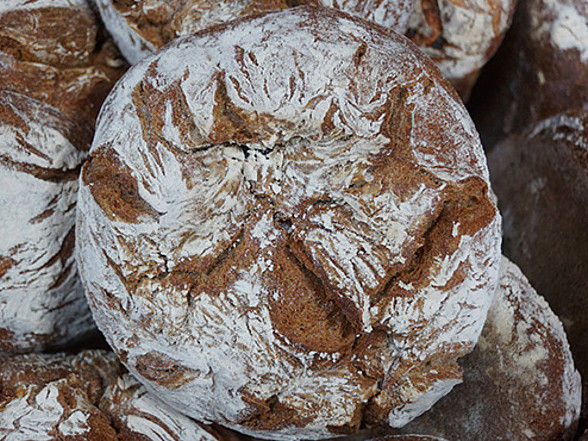Acrylamide: The right grain can reduce hazardous substance in baked goods.
According to a recent study by the University of Hohenheim, the selection of grain types and milling have a major influence on the amount of acrylamide that can be expected in wheat bakery products.

The potentially carcinogenic acrylamide can occur in starch-containing foods when exposed to high temperatures. A new study carried out by the University of Hohenheim shows how starting materials in cereals can be reduced by selecting the right varieties.
Universität Hohenheim
Acrylamide is regarded as a potentially carcinogenic substance that is produced in starchy foods when exposed to high temperatures - for example when baking bread and other baked goods. According to a recent study by the University of Hohenheim in Stuttgart and the Im Hoppenlau Commercial School, the preliminary stage of acrylamide can be reduced by up to 70% before baking by careful grain selection and in the mill. Sulphur fertilisation on the cereal fields and prolonged dough rest can also reduce the formation of acrylamide, as the University of Hohenheim has already shown in earlier studies. Reason for the recent investigations was the decision of the European Union commission to tighten the standard values for acrylamide in food.
Frying, toasting, baking or roasting - acrylamide, which is suspected of being carcinogenic, is produced when food is heated and browned to a great extent. Chips, French fries and coffee in particular therefore show high levels of acrylamide.
"In normal bread, the acrylamide content is significantly lower and actually only present in the crust," says Dr. Friedrich Longin of the Landessaatzuchtanstalt at the University of Hohenheim. "However, the situation is different for biscuits and especially for biscuits, gingerbread and crispbread".
New EU regulation: bakery products should also contain as little acrylamide as possible
In April 2018, the EU Commission again lowered the guideline values for acrylamide in foodstuffs, for example from 80 to 50 micrograms per kg in wheat bread and from 150 to 100 micrograms per kg in bread made from cereals other than wheat. This was also the case for comparable products such as chips, French fries and coffee, where much higher acrylamide guideline values apply: 400 micrograms for coffee, 500 for French fries and 750 for potato crisps.
"The new regulation has motivated us to take a closer look at possible differences in the choice of grain type and variety for the grain industry," says Friedrich Longin. "And this was well before the baking process, in the choice of the variety and in the production of the flour.
In their study, the researchers concentrated on the precursor of acrylamide, known as asparagine. How much of the presumably carcinogenic acrylamide is produced depends on the baking process, but is strongly related to the amount of asparagine in the raw material. "For this reason, a low asparagine content is one of the best preventive measures to ensure that little acrylamide is present in the product later.
Selection of cereal varieties can reduce acrylamide risk by 70%.
For its study, the University of Hohenheim cultivated 150 wheat varieties at three locations in Baden-Württemberg, ground the grains into wholemeal flour and determined the asparagine content.
Even the scientists were surprised by the range of results: "During the analysis we found very large differences between the wheat varieties. The asparagine contents varied between 140 and 450 mg per kg wholemeal flour," continues Friedrich Longin. By choosing the right wheat variety alone, the asparagine content can be reduced by almost 70% at the beginning of the value chain."
Grain breeding permits further risk reduction
This value could even be further reduced by breeding, according to another result of the research group. "Genetic investigations have clearly shown that the asparagine content is determined by the environment but even more by heredity," explains M.Sc. Matthias Rapp from the University of Hohenheim.
However, breeding cereals with a low acrylamide risk is expensive: "We also found that the asparagine content is influenced by comparatively many genes. This makes breeding more complex and only slow breeding progress can be expected," said Matthias Rapp.
So far, asparagine content has obviously not played a role in breeding, as the Hohenheim scientists have also proven. "There were both modern and old wheat varieties with a very low and high asparagine content," explained Matthias Rapp.
Financial incentives are probably necessary: "I assume that wheat growers will only breed to low asparagine contents if the grain industry clearly demands this in the form of price premiums".
Study also applies to old wheat species such as spelt, emmer and einkorn
After the surprising findings with bread wheat, the grain specialists extended their investigations to the old wheat species spelt, emmer and einkorn. For this purpose, 15 varieties of each species from three cultivation sites were processed back into wholemeal flour and tested for asparagine content.
"As with bread wheat, the variety values for emmer and spelt fluctuated in a similar range," reports Friedrich Longin. "Here, too, the acrylamide potential of the bakery products can be reduced by selecting the varieties early in the value chain".
"The same applies to einkorn," adds Matthias Rapp, "but at a concentration of about twice as much. A further experiment showed why this is the case.
Degree of flour milling influences possible acrylamide contents
In cooperation with the commercial school Im Hoppenlau, Friedrich Longin and Matthias Rapp also investigated the influence of further processing into flour. To this end, five bread wheat varieties from two locations were converted into the most frequently used flour types and the asparagine content determined.
"The amount of asparagine in wholemeal flour was about the same as in type 1050 dark bread flour," reports Dr. Andreas Baitinger, Deputy Head of the Im Hoppenlau Commercial School. "However, only a minimal fraction of the asparagine was still present in the fine Type 550 extract flour. And this flour is mainly used in the bakery".
The reason for the differences is that most of the asparagine is found in the aleurone layer, which is quite far out in the grain. For this reason it is mostly only found in darker flours.
"This is probably also the reason for the significantly higher asparagine content in whole grain flour," Baitinger continues. "Einkorn has a clearly smaller grain. In relation, it has proportionately more boundary layers and less grain interior".
Whole grain products remain valuable from a health point of view
Nevertheless, the scientists strongly advise against avoiding wholemeal bread for supposed health reasons. "Especially the outer layers of the grain contain an abundance of positive ingredients, so that a frequent consumption of wholemeal bakery products is very important for human nutrition", all scientists emphasize unanimously.
In this respect, other strategies for the reduction of acrylamide are required in wholemeal bakeries. In addition to choosing a suitable type of grain, this is also possible by fertilising the grain fields with sulphur, prolonging dough rest and avoiding excessive heat during baking, as the University of Hohenheim has already shown in previous studies.
Proven strategies: long rest periods for dough and less heat during baking
More than 10 years ago, Hohenheim scientists were able to gain important insights into the reduction of acrylamide in bakery products. "A lack of sulphur in the cultivation of wheat leads to drastically increased acrylamide contents. Farmers should ensure a sufficient supply of sulphur when growing wheat," said Prof. Dr. Gräff-Hönninger, co-author of the study at the time.
Baking technology also has numerous possibilities to reduce the amount of acrylamide in finished baked goods. "If the amino acid cysteine is added to the flour, it acts as an interceptor, so to speak, and has an inhibitory effect on the formation of acrylamide," adds Prof. Dr. Dr. Reinhold Carle, food scientist at the University of Hohenheim.
However, science also offers simpler solutions for household use in order to avoid the toxin. Food technologists have discovered that bread from convection ovens leads to a higher acrylamide content due to the faster drying of the dough surface and the more intensive crust formation. Therefore either bake briefly at a higher temperature (280°C) or longer and not so hot (200°C).
A further, easily convertible possibility is to let the bread dough rise for a long time. Because then the yeast consumes the asparagine and the acrylamide potential decreases.




























































